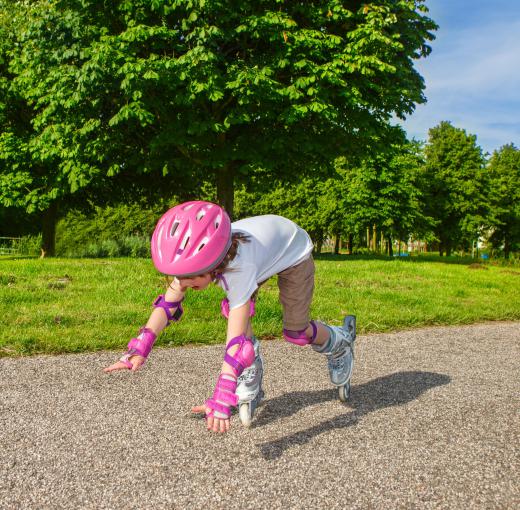In-line skates are roller skates which feature 4 or 5 polyurethane wheels in a straight formation. These wheels are often mounted under a modified hard shell ski boot for added stability. In-line skates are commonly called 'rollerblades', but this is another example of a generic trademark. Rollerblade is actually a registered brand name belonging to the Rollerblade company, considered to be the pioneers of modern in-line skates.
Because modern in-line skates did not appear until the 1980s, many people assume that the traditional quad-skate (four wheels in a two-by-two configuration) was invented first. In actuality, rudimentary versions of in-line skates can be be found as far back as 17th century Holland. As a summer trainer, some Dutch ice skaters would attach wooden spools to the bottoms of their shoes in an in-line formation. These early in-line skates, however, did not benefit from such modern conveniences as ball bearings, axles or brakes.

One inventor in the 1820s actually patented a form of in-line skates called the Rolito, but it was largely ignored by the public. Meanwhile, the quad-skate would not see the light of day until at least 1863, and did not become popular until ball bearings, toe stops and a flexible axle were added in the 1880s. In-line skates continued to be used as trainers for dedicated ice skaters, but were not embraced by the general population at skating rinks.

In 1979, two brothers rummaged through a pile of old sports equipment and found one pair of in-line skates, presumably from a training center for ice skaters. They replaced the wheels with modern polyurethane ones with ball bearings, then attached the assembly to a hard plastic ski boot. A few years later, their invention hit store shelves as 'Rollerblades' and became a sensation among the younger crowd. Early Rollerblade models did not feature a reliable braking system or a flexible axle, but they did allow skaters to develop basic freestyle tricks.
Several other companies have since begun producing in-line skates, even replacing the hard shell ski boot with a softer sport shoe in some models. Modern in-line skates have brakes, various wheels for different terrain, and better protective gear for users. In-line skates can be used in skating rinks or at skateboard parks. Experts recommend that beginners use the four-wheel configuration for better control. The five-wheel in-line skates are best left to experienced skaters looking for more speed.
The basic technique for in-line skating is very similar to ice skating. One skate is pointed forward as the skater pushes off to the side with the other skate. As the momentum propels the first skate forward, the other skating leg is held in the air momentarily. When the skater senses the forward motion slowing down, the opposite skate is pointed forward and the first skate becomes the pusher. Skaters alternate from leg to leg, pushing off and then gliding. Stops are accomplished by either turning the skates at a sharp angle, running into a grassy area, grabbing a stationary object or using the rubber stops on the skates themselves.
